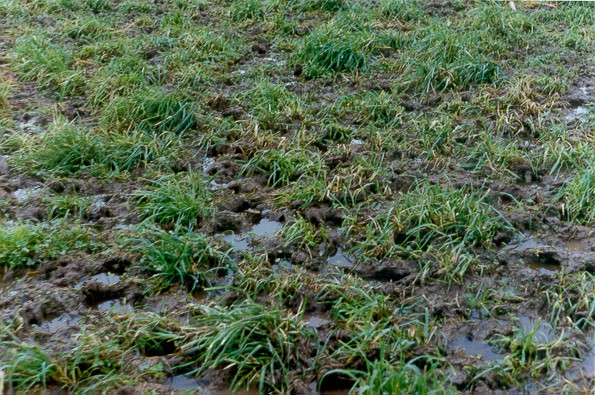Grazing management to reduce soil damage
Wet soils lose their strength and are easily pugged by dairy cows when grazed. The treading and pugging damage destroys soil structure, making it harder for rain to infiltrate readily, and making the problem worse for later grazings.
Past work in southwest Victoria showed that even in a dry winter, pugging damage from one grazing in August reduced the regrowth of pasture considerably over following months.
Improved pasture species such as perennial rye and white clover are replaced by poorer species such as winter grass, docks, buttercups and fog grass. The severely pugged areas don't recover readily, particularly on heavier (clay) soil types and may need resowing.

Grazing management techniques
The following grazing management techniques can be used to reduce the effects of pugging.
Note that even drained paddocks will need to be treated this way during and immediately after rainfall to protect the drainage system.
Allocate day and night feeds separately
- By allocating about two-thirds of the feed during the day and one-third at night, there's less contamination of the night feed. Cows walk less and rest more.
- Graze in blocks rather than strips.
- Pasture cover should be 2200kg to 2400kg of dry-matter per hectare (kg/ha) otherwise extensive pasture damage is likely to occur, which will require off-paddock feeding with supplements.
- Extensive pasture damage can occur if grazing pastures shorter than this. In this situation cows should be taken 'off' the paddock. They will probably need extra hay, silage or grain to meet the shortfall in feed.
Shift fence several times a day
- Using the above technique of two-thirds a day, one-third at night, shift the fence 2 to 3 times during the day to reduce contamination and pugging on the daily allocation of pasture.
- If feeding hay, place it on the next area to be grazed before cows have access to it. This minimises trampling damage.
- Small square bales of hay can be put out (strings uncut) several days ahead of the grazing.
Slow the rotation
- Begin in early autumn with a slow rotation to build a feed wedge for winter. Aim for 2200kg to 2400kg DM/ha of pasture at grazing.
- If the rotation is too fast, then pasture cannot reach optimum growing height. As a result, you'll need more supplementary feed in winter to fill the gap. The cows will also return to the wet, damaged paddock sooner, causing greater damage.
Backfence as often as possible
- Backfence when cows graze a paddock for more than 1 day.
- Strip grazing without a backfence reduces regrowth.
- The more times a wet soil is walked over, the weaker the soil becomes and the greater the pugging damage.
Have cattle graze longer grass
- Longer grass has as flotation effect and protects the soil more than shorter grass.
- Cows find it easier to eat their pasture requirement and so are less likely to walk around the paddock searching for extra feed.
- Regrowth will be faster from the taller pasture.
Allocate a larger grazing area
- Usually not recommended as this speeds up the grazing rotation. This results in less grass being available at the next grazing. If used, should only be done for 1 to 2 days at a time
- Total pugging damage will be as bad if not worse than if a smaller area had been grazed, but is less noticeable because it is on a larger area.
- If pasture is short (less than 1800kg/ha) then severe pugging damage can be expected.
Apply nitrogen fertiliser
- Nitrogen applied early will help build up a feed wedge for winter.
- Do not apply to waterlogged pasture, as response will be poor.
- Ensure other elements such as phosphorus and potassium are not limiting.
Destock as a last resort
- If available, agistment (or some other arrangement to get animals off the property) is an attractive option — providing it's reasonably priced, fencing and watering are adequate and that the animals are regularly checked.
- Sell cattle only in extremely wet conditions as a last resort. Cattle prices would probably be low if wet conditions were widespread and other farmers also were forced to sell animals. Restocking may then be at a time when demand is high, and so is the repurchase price.